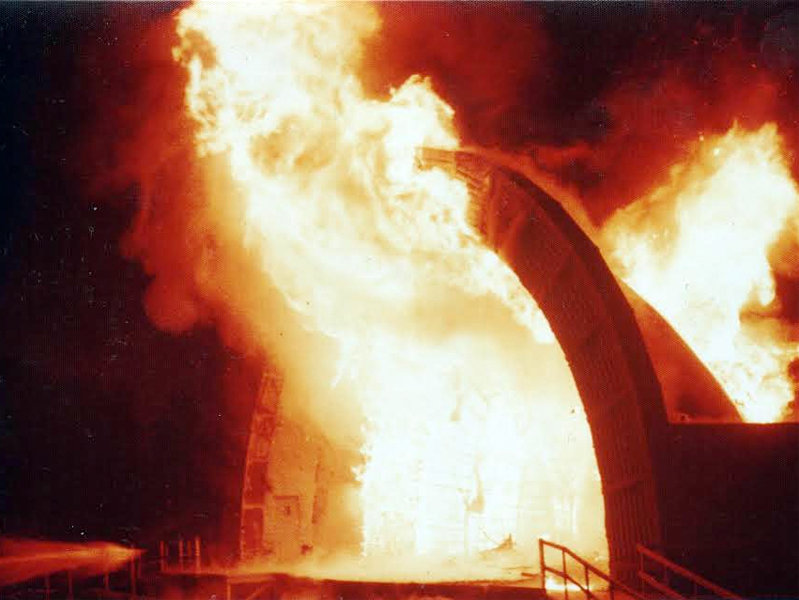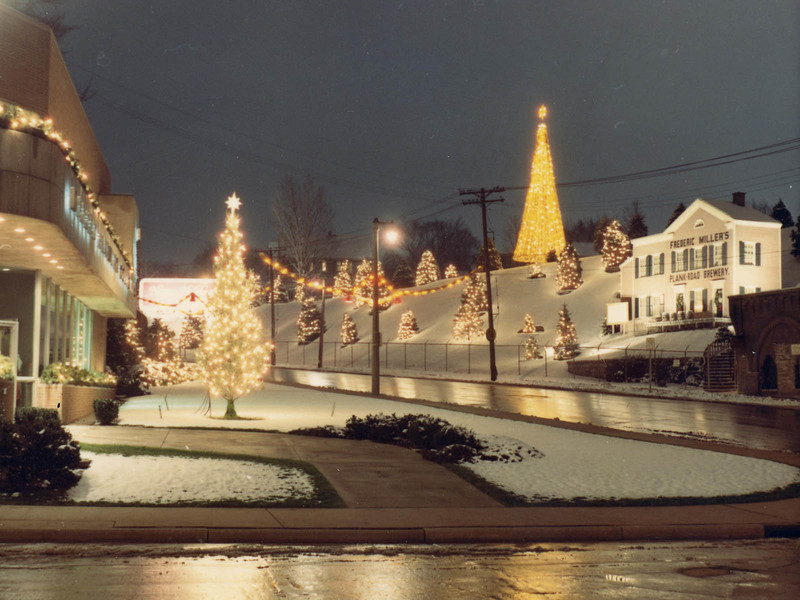A high-profile lot that’s been vacant except for parking for more than 50 years will get a new hotel.
On Tuesday, the Business Journal reported that a plan build a eight-story Hilton Tempo hotel – designed by Milwaukee’s Kahler Slater – is finally moving forward.
The 161-room hotel, which is a Milwaukee HKS Holdings LLC project that was first reported nearly two years ago, will get a review by the Historic Preservation Commission at its Jan. 9 meeting.
That got me thinking – with a nudge from my friend Jeff Bentoff – about what occupied the site in the past.
Most recently, that would’ve been the “Fountain of Communication,” which following the 1962 addition to the Journal building, which has now been converted to student housing for MATC.
The fountain, which had seven vertical panels at the back – reflecting the exterior of the new addition – and three semicircular elevated above the main reflecting pool.
Water would spout up from the top-most pool and cascade through spillways in segmented flows that echoed the vertical panels into the lower pools before ending up in the main pool.
The fountain was flanked by two matching semicircular garden beds and the whole thing was raised slightly from the Kilbourn Avenue sidewalk on a brick and Kasota stone base.
The metalwork for the fountain was executed by Milwaukee’s Metal Craft, Inc., and a series of sprites was added to the vertical panels. Those were designed by Milwaukee artist Dick Wiken.
While a few sources suggest that the 198 fountain was redesigned and the sprites added in 1979, this 1969 photo from the collection of the Milwaukee Public Museum clearly shows them in place at least a decade earlier.
And, according to Anna Passante’s book on the artist, Wiken told the newspaper that the “water sprites,” represented, “music, photography, writing, electronics, the telephone, news and advertising, and raising an alarm in the public interest,” in 1968.
According to Passante, the Milwaukee fireboat Deluge sent up a stream of water to kick off the May 8, 1968 dedication ceremony.
Decades later, the fountain was removed to expand the Journal parking lot, the Wiken sprites were saved and mounted to posts along 3rd Street.
Also on 3rd Street, you’ll find this plaque, which reads:
“The Republican House, a hotel that stood on this site from 1886 to 1961, was the birthplace of baseball’s American League. On the night of March 5, 1900, Milwaukee attorney Henry Killilea, his brother Matt, Connie Mack, Byron (Ban) Johnson, and Charles Comiskey gathered in Room 185. In defiance of the existing National League, Comiskey’s Chicago White Stockings (later Sox) were incorporated, and the league's eight team alignment was completed. After the 1900 season, the league reorganized, placed teams in Baltimore, Boston, Philadelphia, and Washington, D.C., and acheived major league status.”
Many decades later, of course, Milwaukee would become home to the office of the commissioner of Major League Baseball Bud Selig.
The Republican House stood for more than a century on the northwest corner of 3rd (now King) and Kilbourn, in a couple incarnations.
The first was a small, three-story wooden hotel building with porch-like balconies running along the entire front of the second and third floors.
It had initially stood on Cherry Street, between 2nd and 3rd, before being moved – exactly when is unknown, though it appears to have been in its new location at least by the 1850s – to the site in question.
Built as the Washington House in 1836 by Deacon Samuel Brown for Chicago businessman Archibald Clybourn, who owned businesses in Milwaukee but did not live here. That’s perhaps why he overbuilt his hotel, leading some to opine at the time that it was too large for the city’s needs.
A 1961 Journal article noted without elaboration that, “linked with the building are many pioneers. Benjamin Church and Morgan L. Burdick are others who had a hand in its building.”
That same article noted that when ground was broken for Byron Kilbourn’s Rock River Canal – the only portion of which was ever built is now filled in and called Commerce Street – in 1839, big celebration was held at the hotel.
William A. Webber is said to have installed Milwaukee’s first billiards table at the hotel, and in 1858, a camera obscura from Paris was installed on the roof by an E. Weissner who was interested in selling it. He allowed visitors to check out its “life-like picture of Milwaukee.”
It was also the first hotel in the state to have electricity, the second in the country to have refrigeration for its kitchen and the first to build a hall within the hotel to host conventions.
“It was Dec. 31, 1875, when the Kletzsch family took charge of the famous hotel,” wrote the Journal. “Charles F. Kletzsch, father of the boys, leased it at that time and conducted it without any notable change until 1880, when he purchased the property and erected the first unit of a number of additions,” including one in 1883.
In 1884, the corner portion of the building was torn down and a new addition that connected two existing wings was built, creating a four-story, Victorian Italianate beauty that boasted a couple towers, including one in the second empire style.
It was designed by Frederick Velguth, who also drew Trinity Evangelical Lutheran Church.
Like its predecessor, it had balconies running along all the upper floors, but this time they were on two sides, not just the front.
Four years later, Charles Kletzsch retired and his sons Alvin P. Kletzsch and Herman O. Kletzsch took over and they further expanded the hotel in 1892 and 1900.
The operation shifted to Ray Smith, who ran The Pfister, but in 1929 returned to the Kletzsch brothers and the following year the Republican House suffered a big fire likely started when someone threw a cigarette into a laundry chute.
No one was killed, thankfully, and the hotel survived, too, for another 32 years.
William George Bruce, close friend of the Kletzsch family owners of the Republican hotel, had retired for the night when called to be informed of the fire in the hotel.
“It was one of the most famous hotels of the state,” the Journal quoted William George Bruce as saying at the time of the fire. “It was for many years one of the most popular hotels in the city, especially with people from the central and northern sections of the state. It was the scene of many of the old social gatherings, those of the German-American element predominating.
“The old hotel was started by Charles F. Kletzsch, who took it over when it was little more than an old boarding house. That was when it was a frame structure. Under his management it rapidly became noted for this wonderful hospitality and excellent table. It was soon torn down to make room for the first unit, built of brick and stone. The new Republican house continued to prosper and three times the building was enlarged by the addition of other units.”
Bruce noted that the Kletzsch boys also operated Madison’s Park Hotel.
“Being not far from the old Exposition building, where all of the state political conventions and caucuses were held, the hotel, under the skillful direction of Alvin and Herman, was considered exactly what its name said, the republican hotel of the state,” Bruce continued.
“In its guest rooms and meeting rooms many a candidacy has been doomed to bud and die unseen and unknown. Many a prominent figure in state politics had his first acceptance in those secret meetings of the old republicans in the old Republican hotel.”
In 1961, the building was torn down to make way for a parking lot to complement with Journal’s and this local institution ended a run of 125 years.
Now, it will be returned to use as a hotel, this tme under a Hilton brand banner that is only a couple years old.
“A thoughtfully designed place that invites you to live in the moment and gives you space to rest and recharge,” reads the brand webste. “All while being warm, inviting, and within reach.”
In Milwauke that will include a restaurant on the ground floor and a rooftop events space wth outdoor patio.
HKS Holdings LLC is the developer that built the Kimpton Journeyman in the Third Ward and the Renaissance Milwaukee West in the outlot at Mayfair Mall.
The hotel will be located a block from the Wisconsin Center, which is currently being expanded and is due to open in 2024.
Born in Brooklyn, N.Y., where he lived until he was 17, Bobby received his BA-Mass Communications from UWM in 1989 and has lived in Walker's Point, Bay View, Enderis Park, South Milwaukee and on the East Side.
He has published three non-fiction books in Italy – including one about an event in Milwaukee history, which was published in the U.S. in autumn 2010. Four more books, all about Milwaukee, have been published by The History Press.
With his most recent band, The Yell Leaders, Bobby released four LPs and had a songs featured in episodes of TV's "Party of Five" and "Dawson's Creek," and films in Japan, South America and the U.S. The Yell Leaders were named the best unsigned band in their region by VH-1 as part of its Rock Across America 1998 Tour. Most recently, the band contributed tracks to a UK vinyl/CD tribute to the Redskins and collaborated on a track with Italian novelist Enrico Remmert.
He's produced three installments of the "OMCD" series of local music compilations for OnMilwaukee.com and in 2007 produced a CD of Italian music and poetry.
In 2005, he was awarded the City of Asti's (Italy) Journalism Prize for his work focusing on that area. He has also won awards from the Milwaukee Press Club.
He has be heard on 88Nine Radio Milwaukee talking about his "Urban Spelunking" series of stories, in that station's most popular podcast.







